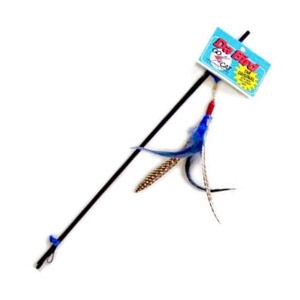 This is an excellent way to get some natural Kitty aggression, stalking, pouncing and attacking directed into proper play. Also, it is another important bonding experience with your furry friend. This will teach them to play in an appropriate manner.
This is an excellent way to get some natural Kitty aggression, stalking, pouncing and attacking directed into proper play. Also, it is another important bonding experience with your furry friend. This will teach them to play in an appropriate manner.
We can take the cat out of the jungle, but we can’t take the jungle out of the cat. There is a little tiger in every house cat, a solitary predator that needs to exercise its hunting skills on a regular basis. We may have confined this little tiger within four walls, provided them with the finest of feline foods, but we can’t ignore their basic need to do that for which it was so perfectly designed – to HUNT. Fortunately, it is not always necessary for the prey to be alive, but it must move.
Owners are often frightened by the playfully aggressiveness in cats and kittens because they look quite intense when they play. They silently ambush feet and ankles as they pass by surprising, upsetting, and sometimes, even hurting a family member. In some cases the cat owners have not intentionally trained their cat to be a feline terrorist by playing with it as a kitten with their hands or feet. The solution is to direct the cat’s playful, predatory, energies toward toys instead of moving hands or feet.
 Of course, the easiest solution, and perhaps the best, is to get another cat or kitten of the same sex and approximately the same age and activity level as a playmate for your them. Although you will now have two mouths to feed, the wear and tear on you and your home will be greatly reduced or eliminated. If getting another pet is not possible, then it will be your responsibility to provide your playful cat with scheduled sessions of controlled play.
Of course, the easiest solution, and perhaps the best, is to get another cat or kitten of the same sex and approximately the same age and activity level as a playmate for your them. Although you will now have two mouths to feed, the wear and tear on you and your home will be greatly reduced or eliminated. If getting another pet is not possible, then it will be your responsibility to provide your playful cat with scheduled sessions of controlled play.
Schedule two or three (more, if necessary) interactive play sessions a day for times when Kitty is most rambunctious. Cats love routine, so try not to change the play times. Depending on how athletic your cat is, the sessions may last 10-20 minutes each, every cat and kitten will be different and require more or less time. A fishing pole type toy enables the pet parent to be stationary while controlling the cat’s activity level with a flip of your wrist. Some of the best commercially sold toys for this purpose are the “Da Bird” and the “Cat Charmer”. The play sessions should not stop until the cat is exhausted, lying on their side and batting at the toy because they are too tired to jump or chase after it.
During the play session make the toys move as wild prey-a little mouse or bird would. Don’t dangle the toy in the cat’s face. It should hide behind objects in the house and occasionally jump into the air. Build up Kitty’s confidence and enthusiasm by allowing plenty of “captures” and praise. After play fishing pole toys should be carefully stored out of the cat’s reach, if left out they could become entangled in the toy which could cause great harm and fear.
As kittens mature, the play patterns of male and females change. The rough-and-tumble, pounce-and-play sequence of male play behavior will continue and may not be appreciated by the female. When she is older he may be greeted with hisses and spitting, this is normal, she is simply telling him to slow down and back off. Both kittens and cats need these play sessions, it will keep them trim and very happy.
We are using the words of the late Betsy Lipscomb, founder of Cats International. Betsy was a champion of all cats and spent her life helping humans solve their feline problems to avoid de-clawing or euthanasia. She is remembered lovingly by all lives whom she has touched.


